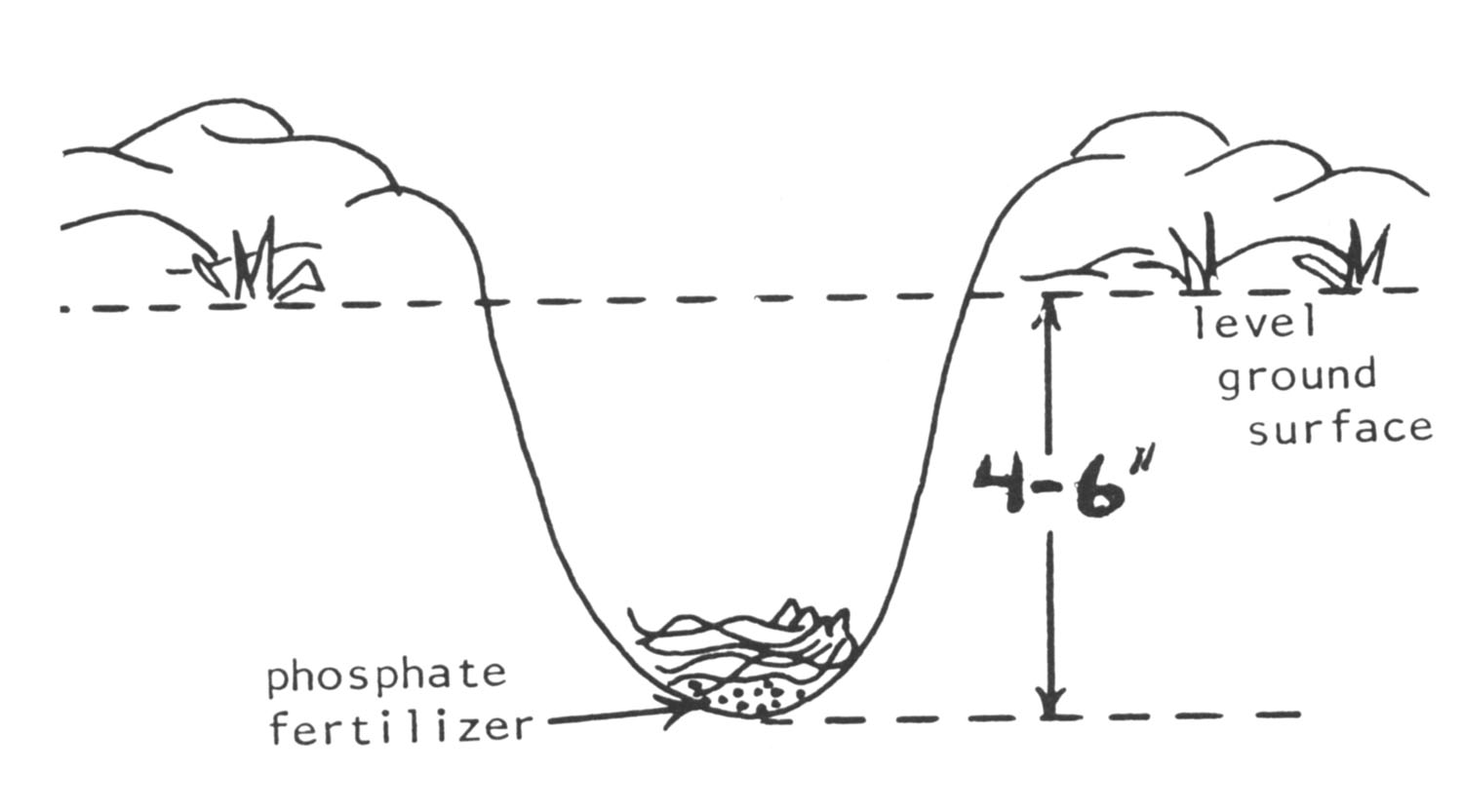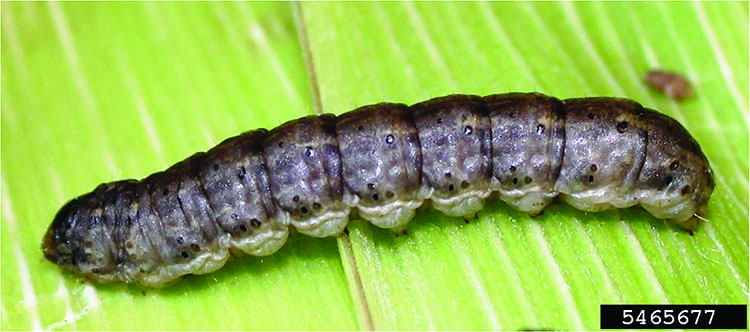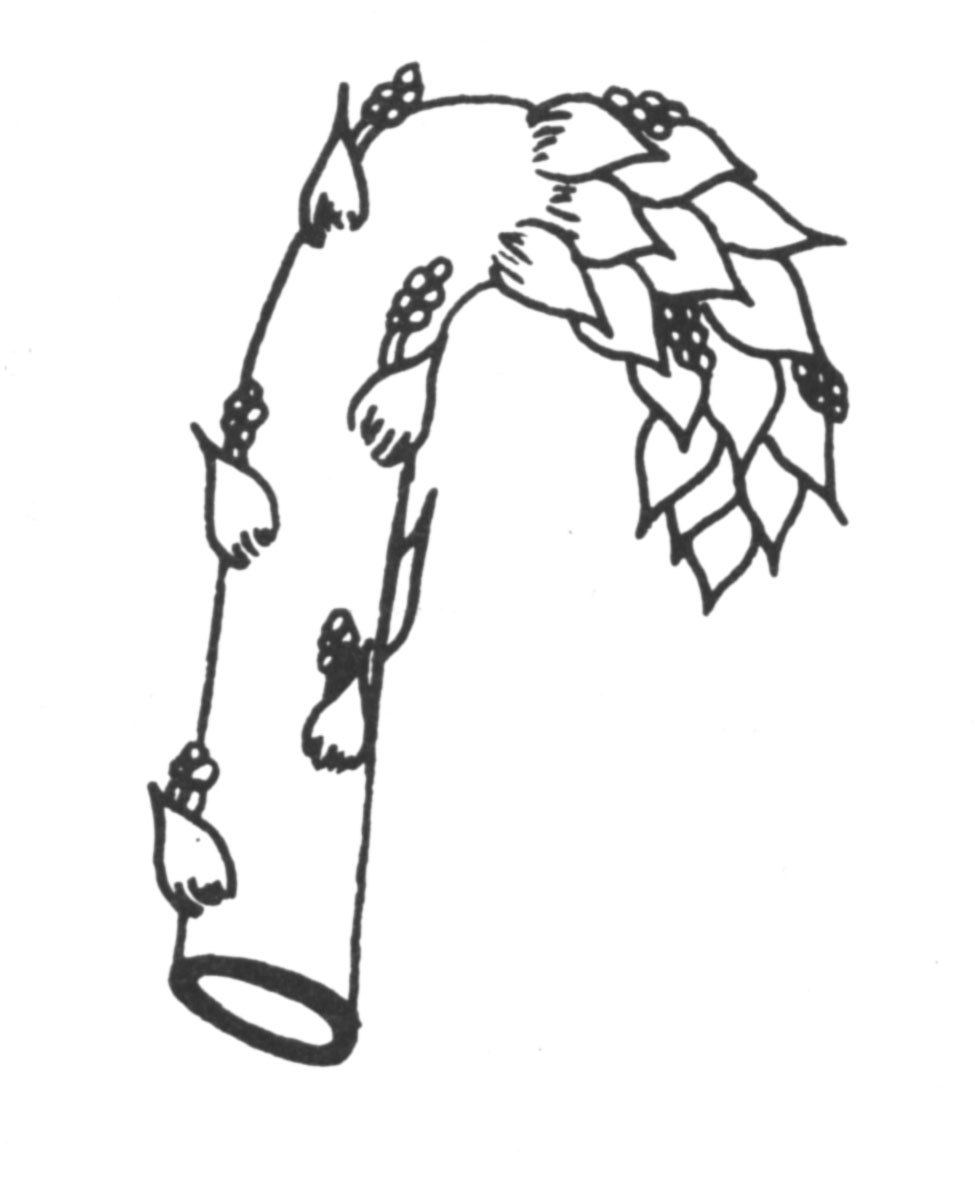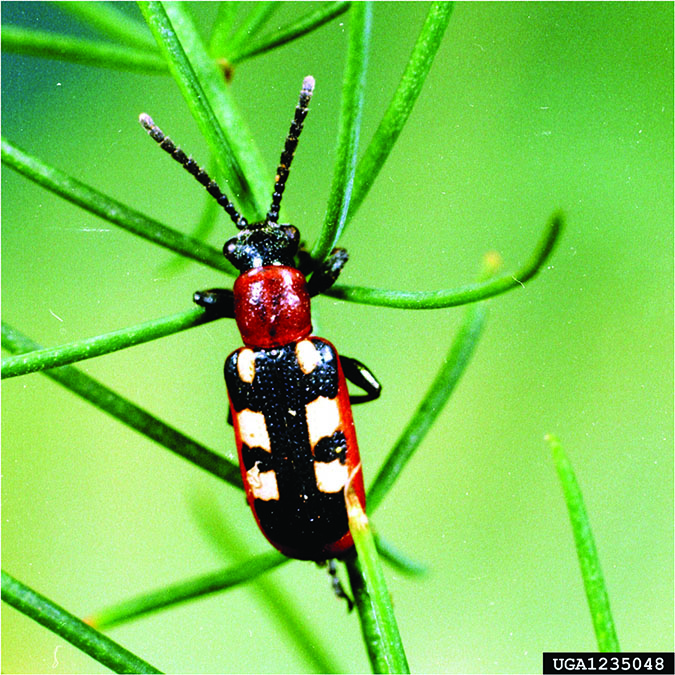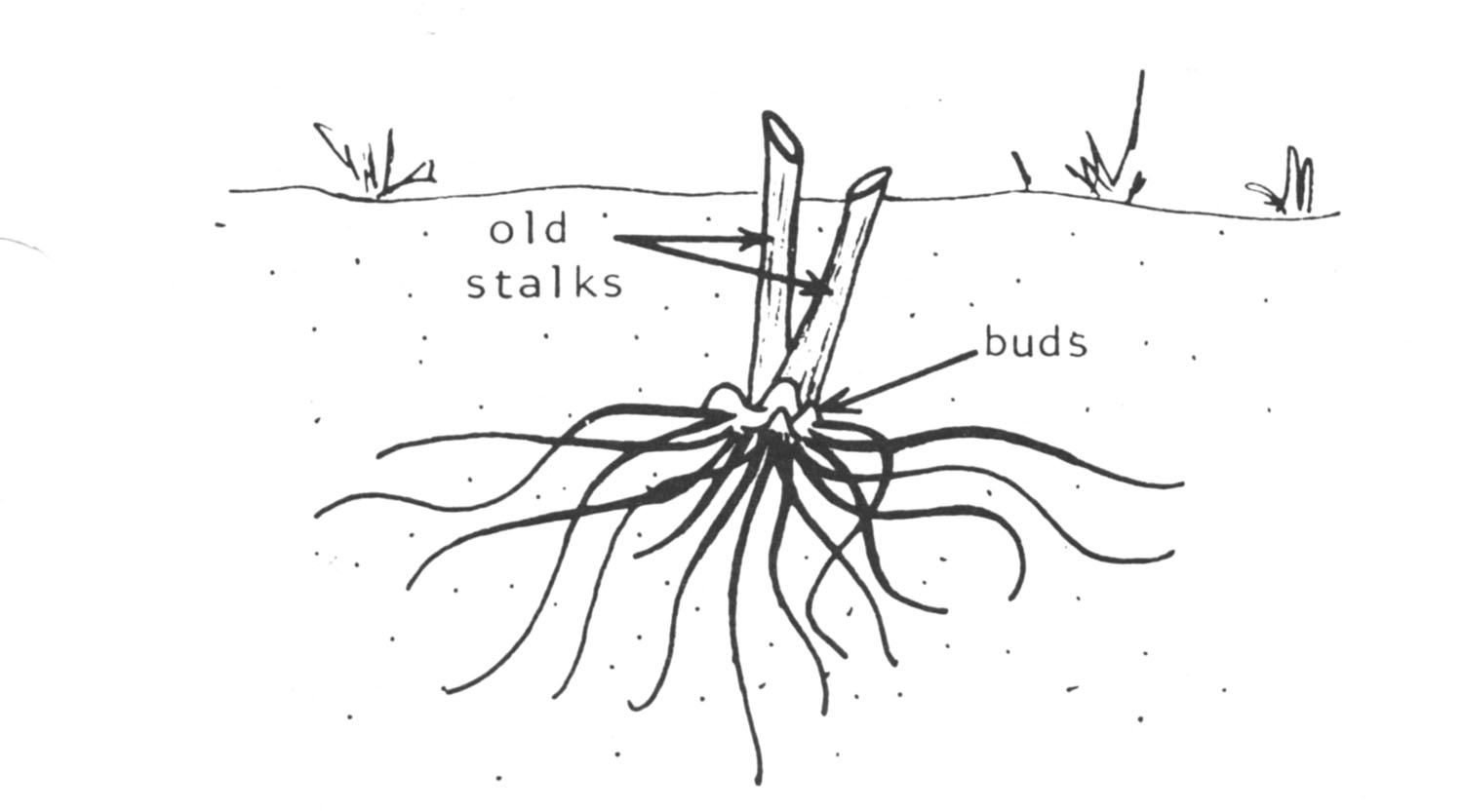Asparagus Production
- Jump To:
- Production Requirements
- Varieties
- Sites and Soils
- Soil pH and Fertilizer
- Fertilizing the First Year
- Fertilizing Established Plantings
- Irrigation
- Soil Preparation and Planting
- Growing Asparagus Crowns and Transplants
- Digging Crowns
- Setting the Crowns
- Pest Management
- Diseases
- Preparation for Harvest
- Harvesting
- Harvesting Decision Examples
- Handling Asparagus after Harvest
- Marketing
- Costs
Production Requirements
Asparagus is a valuable crop and one of the earliest of spring vegetables. It is a perennial, and plantings may remain productive for 15 years or more. Spear size and yield will decrease after 12 to 15 years. A planting should produce 2,500 pounds or more per acre of snapped asparagus during each of its most productive years. Yield is dependent on the amount of carbohydrates stored in the underground crown of the plant and is directly related to the previous season’s fern growth. Longer growth periods and more vigorous fern growth equates to more carbohydrates stored in the crown. Stress from Cercospora blight (Cercospora asparagi) (see Extension Fact Sheet EPP-7646) and from weed competition, drought or overharvesting weakens the plant and reduces fern growth and energy storage. As a planting becomes less vigorous due to these stresses, the spears will become smaller each year. Controlling stresses is a key part to maintaining a vigorous and productive planting of asparagus.
Varieties
There are only a few varieties of asparagus available for plantings. Historically, various strains of Mary Washington have been used, but modern hybrids are considerably more productive and have consistently out-produced this older variety (see fact sheet HLA-6035 “Commercial Vegetable Varieties for Oklahoma”). U.C. 157 F1 and U.C. 157 F2 perform very well with conditions in Oklahoma. Several new all-male hybrids developed by Rutgers University were tested at Bixby, Oklahoma, and produced very high yields there as well as in other areas of the state. Rutgers hybrids include Jersey Gem, Greenwich, Jersey Giant and Jersey Queen.
The Rutgers University all-male hybrids out-yielded U.C. 157 F1 by 20 to 50 percent, however all the Rutgers hybrids tend to fern-out and get loose spear heads at shorter spear heights than desired with warm (above 85 F) harvest conditions. This is usually during the last three weeks of May in Oklahoma. To maintain high spear quality, these varieties must be harvested at six to seven inches in length and will not make the desired 9-inch high spears during warm conditions in May.
Sites and Soils
Asparagus can be grown in many soil types, but deep loam or sandy soils with good surface water and air drainage are best. Good production is also possible in heavier soils. In asparagus production, it is important the plants develop an extensive storage root system therefore, good soil drainage is essential. Asparagus roots can develop to a depth of ten feet in well-drained soils. Most soils are acceptable, if the water table does not come within three feet of the surface during the growing season. Asparagus will thrive in soils having a salt content too high for many other crops, but it will not tolerate extreme acidity. Although asparagus will tolerate less than optimal soil conditions, yields are likely to be reduced and the life of the planting will be shortened in these soils. Soils subject to spring wind erosion may need windbreak strips planted to protect tender asparagus spears during harvest.
Soil pH and Fertilizer
Asparagus prefers slightly acidic soils. Soils with a range of pH between 6.0 to 6.8 works well for asparagus plantings. For more detailed information about soil types and fertility needs of asparagus, see Extension Fact Sheet HLA-6036 “Soil Test Interpretations for Vegetable Crops” or check on-line for crop-specific soil test recommendations by the OSU Soil Testing Lab.
Fertilizing the First Year
Before planting asparagus, have the soil tested in the late fall or early spring. The soil test results will determine the amount of fertilizer to be applied in the spring before setting the crowns (Table 1). Along with the recommended phosphate and potash fertilizer, apply 50 pounds of nitrogen per acre. Plowing the fertilizer under puts it at the best depth for asparagus crowns. In addition to the amount of fertilizer recommended above, phosphate fertilizer should be applied down the furrow before setting crowns (250 pounds per acre 0-20-0 or 100 pounds of 0-46-0). Newly set crowns should be sidedressed with 30 pounds per acre nitrogen at the first cultivation.
Table 1. Phosphorous and potassium requirements for asparagus.
| Phosphorous Requirements (lbs P2O5/Acre) | |||||
|---|---|---|---|---|---|
| When test shows | 0 | 10 | 20 | 40 | >65 |
| Add lbs. P2O5 | 200 | 170 | 140 | 80 | 0 |
| Potassium Requirements (lbs K2O/Acre) | |||||
| When test shows | 0 | 75 | 125 | 200 | >250 |
| Add lbs. K2O | 200 | 155 | 120 | 50 | 0 |
Fertilizing Established Plantings
The objective during the first two years after planting crowns is to develop maximum fern growth, allowing plants to build an extensive storage root system. Any practice that interferes with this objective will have a negative effect on yield and may shorten the productive life of the asparagus.
Before the spring discing the second year (one year from planting), broadcast 70 pounds per acre nitrogen. Each year thereafter, topdress 70 pounds of nitrogen per acre about two weeks before the end of the harvest season (about May 15). At five-year intervals, conduct a soil test, and if recommended, apply any needed lime, phosphate and/or potash fertilizers in addition to the annual nitrogen application. Where available, animal manure is excellent fertilizer for asparagus.
Irrigation
Asparagus is very deep rooted and draws water from a large volume of soil. This allows the crop to withstand considerably more dry weather than other shallow rooted crops. Deep rooting also permits longer intervals between irrigation applications, compared to other irrigated crops. Successful asparagus production in western areas of the state will require irrigation for maximum yields.
Irrigation is important to relieve drought stress, particularly during the first two seasons after crown planting. Dry weather during the cutting season or late in the fern growing season (October) will have little effect on yield. An extended dry period early in the development of the fern after the cutting season is undesirable and may reduce yield the following year. Remember, drought stress on the crop reduces fern growth, therefore reducing potential future yields.
Asparagus may be irrigated by three methods: Sprinkler, furrow or drip (trickle) irrigation. Sprinkler irrigation wets the foliage and can result in more disease problems due to soil splash. Sprinkler irrigation also washes off spray residues if the crop is being sprayed for disease or insect control. One should sprinkler irrigate to maintain the level of soil moisture in the top foot at about 70 percent of field capacity, particularly during the early part of the growing season. Devices such as tensiometers will provide more information on the soil moisture level.
Drip irrigation is another option for asparagus production and minimizes the amount of water used. It utilizes drip tape with emitters through which water is applied under low pressure at a slow rate. The drip tape may be laid out as a sub-surface system using “low-flow” 15mil drip tape buried 12 to 15 inches deep under the plant row prior to planting crowns or seedlings. Advantages to drip irrigation include being able to carry on field operations (spraying, harvest, etc.) while irrigating, reduced disease pressure and increased irrigation efficiency. Using an equal water supply, drip irrigation will provide water to acreages nearly twice as large as sprinkler or furrow irrigation. Another advantage is that sidedress nitrogen can be uniformly applied through a drip system. Refer to Extension Fact Sheet BAE-1511, “Drip (Trickle) Irrigation Systems” for additional information.
Furrow irrigation can be used in certain situations, but field slope and soil type is critical for making this system work. Most furrow irrigation systems have a low irrigation efficiency and require more water than either sprinkler or drip irrigation.
Soil Preparation and Planting
Asparagus occupies the land for many years, so it is very important that soil fertility needs be met and troublesome weeds are controlled prior to crown planting. After planting, it will be very difficult to control perennial weeds such as Bermudagrass or Johnsongrass. Therefore, it is necessary to control perennial weeds prior to planting. Since it is very difficult to improve soil after the crowns are planted, soil improving practices must start at least a year before planting. If soil pH is below 6.0, it should be raised to 6.5 by applying lime according to soil test report recommendations.
Asparagus thrives best in soils well supplied with organic matter. Applications of animal manure or turning under a green-manure cover crop are desirable practices prior to planting asparagus. Manure application to established plantings is also very beneficial. Specific fertilizer application rates are determined by soil testing. Fifty pounds per acre of phosphate (P2O5) should be placed in the bottom of the planting furrows before setting the crowns.
Growing Asparagus Crowns and Transplants
It is best to buy one-year-old crowns from a reliable grower or nurseryman for small plantings or for faster establishment of larger acreages. It may provide a cost savings for the farm to produce their own crowns or to produce seedlings for transplanting into the field, particularly if a larger acreage is to be planted.
To grow crowns, high quality seed should be obtained and planted in soil that has never grown asparagus. Soil should be sandy, so crowns can be easily dug and be free from adhering soil. Phosphorous and potassium fertilizer should be applied, based on soil test recommendations (Table 1) and worked into the soil prior to seeding the crown bed. Approximately 30 pounds per acre of nitrogen should be applied preplant and an additional 50 pounds per acre top-dressed in early July. Seed should be planted in early April in rows 2 1/2 to 3 feet apart. Eight or nine seeds should be planted per foot of row. One pound of seed should produce crowns for planting one acre of asparagus. A planting depth of one to two inches is needed. Asparagus is slow to germinate, requiring two to three weeks for the seedlings to emerge. Crowns are ready to dig after one growing season.
Another option for growing your own is to produce seedlings for transplanting into the field. Expensive hybrid seed will plant double the area, or about 2 acres/pound when transplants are grown. One disadvantage of transplants compared to crowns is the very low yield one year from planting. The major problem with transplants in Oklahoma is due to potential heavy spring and early summer rainfall. This can cause the four-inch deep planting furrows to erode, destroying the small seedlings. The problem is more serious on rolling land. Cost of asparagus transplants is usually similar or less than the cost of crowns. Transplants can be grown in ten to twelve weeks in the greenhouse. Start with high quality seed and containers that allow ample room for root growth and development. Rutgers University suggests using 2-inch by 2-inch width by 3 inches deep containers with straight sides for good root development. Asparagus seed will germinate from 60 F to 80 F with best germination at 75 F. Growing temperature in the greenhouse should also be in the 60 F to 80 F range. Careful management of greenhouse temperature and fertility during seedling development should result in strong plants ready for transplanting to the field after danger from the last frost in the spring has passed.
Digging Crowns
Crowns grown in Oklahoma can be dug in January, February or early March, before bud growth begins and just prior to setting in the field. Old plant tops should be mown and, if necessary, removed from the field, so as not to interfere with digging the crowns. A peanut or potato digger can be used to lift the asparagus crowns from the nursery row. Care should be taken not to injure the crowns during digging. Crowns should be planted as soon as possible after digging.
When it is necessary to hold the dug crowns before setting them in the field, they should be stored in a moderately dry, protected place at a temperature near 40 F. Crowns can become overheated if they are stored in a large pile and excessive drying of the crowns should be avoided. Crowns will freeze at 32 F and severe injury, or even complete loss, can occur if the crowns are allowed to freeze. Frozen crowns become mushy when thawed and must be discarded.
Setting the Crowns
Before planting, separate the individual crowns that are tangled and grown together. Having the crowns separated before going to the field speeds the planting process. While separating the crowns, sort out the small crowns, since they will not compete if planted between two large crowns. Small crowns will produce satisfactorily if planted together in the same row.
Place the crowns by hand in the bottom of planting furrows six inches deep (Figure 1). Workers can carry crowns in buckets or baskets for planting small areas. For larger acreages crowns can be loaded on a trailer which is slowly pulled down the planting furrows. Workers sitting on the sides and back of the trailer drop crowns into the newly opened furrows. It makes no difference if crowns are planted upright or upside down, although they will emerge in less time if planted top up.
The planting furrows should be opened with a middle-buster plow just ahead of planting to provide a loose, moist plant bed. A furrow opener equipped with a fertilizer hopper and a conducting tube to place the phosphate fertilizer in the bottom of the furrow is ideal, but a small spreader following the furrow opener will suffice. Space the rows five to six feet apart. Space plants 12 to 15 inches apart in the row. This requires 6,000 to 9,000 crowns per acre, depending on spacing in and between rows.
Test results from Bixby, OK, indicate planting 9,000 crowns per acre will out yield 6,000 crowns per acre by a small amount for one or two seasons. By the third harvest season, yields are equal with 6,000 and 9,000 crowns per acre. For vigorous and expensive all-male hybrids, planting 6,000 crowns per acre is recommended. The distance between rows may be determined by the harvesting and field equipment to be used. A large percentage of small diameter spears will be produced if crowns are set too close together. In the more humid eastern area of Oklahoma, row spacing of six feet may reduce problems with Cercospora blight disease. Also, running rows north and south will promote faster drying of the asparagus fern and help reduce Cercospora blight.
Cover the crowns with two to three inches of soil immediately after planting. Work more soil into the furrow as growth progresses, or as needed to cover emerging weeds until the furrow is filled, usually by the middle of June. No herbicides are available for use on new asparagus plantings.
Figure 1. Proper crown planting depth with phosphate fertilizer applied in the bottom of the furrow before planting the crowns.
Pest Management
Weed Control
During the soil preparation phase prior to planting, of perennial weeds should be controlled. Perennial weeds such as Bermudagrass, Johnsongrass, etc. must be controlled prior to establishing an asparagus planting. Perennial weeds can be controlled a number of ways, including postemergence herbicides, cover-crops, cultivation and selecting a site with few or no perennial weeds. For information on controlling weeds in established asparagus fields or crown production nurseries see the most recent edition of the OSU Extension Agent’s Handbook of Insect, Plant Disease, and Weed Control (E-832).
Insects
Cutworms: Among early-season pests, cutworms, especially the variegated and black cutworm (Figure 2), cause sporadic but occasionally severe damage. The adults of cutworms are robust moths with dark forewings and light hindwings. Larvae are greasy-looking, dark caterpillars that feed at night. Young cutworms climb plants and feed on spears and ferns of asparagus. Older larvae feed on spears at the soil surface, cutting them at ground level. Depending on the species, early spring damage may be caused by larvae that have overwintered. Moths are active at night and lay eggs on leaves or stems close to the soil surface soon after plants emerge. Damage by cutworms is characterized by spears cut partially or completely at the soil surface (Figure 3).
Management. After spear emergence, check for severed spears or spears that have begun to curl from partial severing. Cutworms are more easily detected at dawn or at night with a flashlight. Damaged plants often occur in a sequence of four or five within a row. Areas that have had a dense stand of weeds often have high populations. Baits are effective when other food is limited, so check for cutworms and apply bait to the field before the spears emerge, especially where cutworms have caused previous damage. If an insecticide spray is used, effectiveness is increased by banding the insecticide at the base of the plant, preferably at or shortly before dusk.
Figure 2. Black cutworm (Agrotis ipsilon). Photo courtesy Adam Sisson, Iowa State University.
Figure 3. Asparagus spears that are damaged at the tip by cutworms feeding or careless workers will grow crooked and unmarketable.
Asparagus Beetles: Common asparagus beetles appear early to mid-April and feed on spear tips. Adult beetles (Figure 4) are easily recognized by their bright, shiny coloration; they have bluish-black wing covers, with yellow, squared spots and red outer margins. Eggs are dark brown to black, oblong and laid in a comb-like pattern on the ferns and spears. When adults lay eggs on the spears, they sometimes become unmarketable because it is impossible to wash off the eggs. Larvae are dark gray with black heads and become plump, humpbacked and sluggish as they mature. Pupae are yellow and develop in a silken cocoon in the soil before emerging as adults. The life cycle takes about three to four weeks during summer and up to eight weeks in the spring or fall. In the summer, three to eight days are required for egg hatch, 10 to 14 days for larval development, and five to ten days for pupal development. Both adults and larvae eat shoots and leaves, but they are particularly devastating when they chew the tips of spears, causing them to scar and turn brown. In addition to feeding damage, larvae also secrete a dark fluid that stains the plants.
Management. No economic thresholds have been established in Oklahoma for correct timing of insecticide sprays. In general, if beetles are present in early spring when spears can be damaged, sprays should be applied to avert any damage to the marketed product. Later in the year, some damage can be tolerated to the ferns, but if a significant amount of defoliation appears imminent, an insecticide should be applied. Many beneficial insects reduce asparagus beetle populations through predation and parasitism. Predators include lady beetle larvae and asparagus beetle eggs are parasitized by tiny, metallic green wasps, Tetrastichous asparagi.
Figure 4. Asparagus beetle (Crioceris asparagi). Photo courtesy Clemson University – USDA Cooperative Extension Slide Series.
Aphids: Aphids are potential pests of asparagus as ferns are growing (Figure 5). Aphids extract plant juices by feeding with their needle-like mouthparts, ultimately resulting in stunted and deformed fern growth. Aphids also produce honeydew, a sticky waste product that may attract ants or serve as a growing medium for black sooty mold fungus. Aphids are tiny, soft-bodied insects that have both winged and non-winged forms. They are usually pale green to gray and can be recognized by their “tailpipe”- like appendages (cornicles), visible on the abdomen under slight magnification. Natural control factors such as predators, parasites and heavy rainfall most often prevent aphid numbers from increasing to damaging levels. If outbreaks occur, insecticides may be needed.
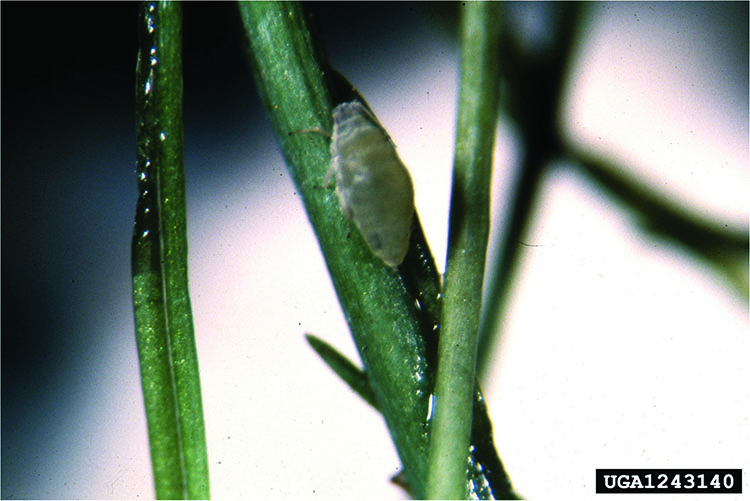
Figure 5. Asparagus aphid (Brachycorynella asparagi). Photo courtesy Whitney Cranshaw, Colorado State University.
Grasshoppers: Several species of grasshoppers may become pests occasionally, especially in late summer when surrounding vegetation begins to dry (Figure 6). Severe defoliation may occur if grasshoppers continue to feed in large numbers. Sustained defoliation may result in decreased yield the following spring or potential loss of the plant stand. Grasshoppers are sometimes difficult to control because of their mobility. Baits, perimeter sprays or foliar insecticide treatments may be necessary if grasshoppers appear in large numbers.
For information on chemical insect control, refer to the latest version of the OSU Extension Agent’s Handbook of Insect, Plant Disease, and Weed Control (E-832).
Figure 6. Differential grasshopper (Melanoplus differentialis). Photo courtesy David Riley, University of Georgia.
Diseases
There are several soilborne and foliar diseases caused by fungi that are economically important in Oklahoma. They include: Fusarium crown and root rot (Fusarium proliferatum), Fusarium wilt (F. oxysporum f. sp. asparagi), needleblight (Cercospora asparagi), rust (Puccinia asparagi), and purple spot (Stemphylium vesicarium). Fusarium crown and root rot and Fusarium wilt usually are introduced into asparagus fields on planting material. Thus, planting disease-free crowns and transplants is the most effective method of control. Asparagus varieties with partial resistance to Fusarium diseases also are available. Needleblight is often misdiagnosed as rust, it is the most common and destructive foliar disease of asparagus in Oklahoma when rainfall and extended dew periods persist during June and July. For detailed information concerning asparagus diseases and their control, consult Extension Fact Sheet EPP-7646 “Diseases of Asparagus in Oklahoma,” and the current edition of the OSU Extension Agents’ Handbook of Insect, Plant Disease, and Weed Control (E-832).
Preparation for Harvest
In late February or early March, the dead fern growth from the previous season must be chopped level with the soil surface with a brush-hog mower (Figure 7). A shallow discing can follow mowing. If lime, phosphorous or potassium fertilizer is needed, it should be applied prior to discing. Even if a no-tillage system is planned, discing is usually necessary to level the field the spring after the crowns are set in the field. A drag behind the disc leaves a level soil surface for herbicide application and harvesting operations. Do not allow the disc to get deeper than needed for controlling weeds and soil leveling, or emerging spears or even crowns may be injured. A no-tillage production system works very well for asparagus and is recommended to minimize soil erosion.
Figure 7. Dormant crown in February or early March. Buds that develop into spears are beginning to elongate beside dead plant stems from the previous growing season.
Harvesting
Asparagus cannot be harvested the year of setting crowns, since it must be allowed to grow and develop a strong storage crown system. With vigorous varieties, high quality crowns, good management and Oklahoma’s extensive growing season, a brief harvest period of about four weeks is possible one year after crown planting, and about seven weeks the second year after planting. About 500 pounds/acre of spear production is possible the next year after crown planting. Spear diameter will be smaller and possibly more difficult to market than the larger spears produced after the first harvest season. In succeeding years, the harvest season can be extended to eight to nine weeks. Anytime the spear diameter becomes less than three-eighths inch in diameter, harvesting should be discontinued. Asparagus spears emerge continually, but there are flushes of spear emergence. Usually there are three to four flushes during the cutting season. Normally, harvest will be during April, May and possibly early June in northern Oklahoma. In southern Oklahoma, harvest will begin seven to ten days earlier than in northern areas. Approximately two-thirds of the production will be harvested during the first one-half of the harvest season.
Asparagus spears can be cut or snapped when they are six to ten inches tall. Harvesting in the morning when the spears are cooler and more easily snapped off is recommended. This also improves quality. The snapping method is faster and less expensive than cutting at or below the soil surface with a long-handled asparagus knife. Always harvest spears when the heads are tight before the tips start to “fern out” (Figure 8). In the early cool part of the harvest season, spears can grow 10 to 12 inches and the heads will remain tight. Fiber content will be low in the base of the spears. In warmer weather, spears will “fern-out” at a shorter height and fiber will develop faster. Therefore, shorter spears must be harvested during warmer weather. Markets can dictate spear length with large wholesale markets requiring 9-inch spears. Other markets may accept shorter spears or asparagus packs with variable spear lengths.
Figure 8. Spears should be harvested when the heads are tight and before they “fern-out.” Left spear is of high quality; middle spear is of lower quality, and right spear is “ferning-out” and is very low in quality.
It will be necessary to harvest daily or more often when the weather is warm. In actual practice, with hired labor, asparagus is usually harvested every second or third day during the earlier and cooler part of the harvest season, but must be harvested every day during warm weather beginning in late April and throughout May in Oklahoma. During cool periods, it may not be necessary to harvest more than two or three times a week. Make sure the field is cut or snapped clean with each harvest. Any ferns that are allowed to grow can harbor diseases and insects. This growth will also delay the emergence of new spears.
If more than two or three acres of asparagus are grown, it may be worthwhile to use a harvest aid machine to carry the workers snapping asparagus. Approximately two hours of labor are needed for one person to pick one acre of asparagus at each harvest. Harvest aids may reduce the labor requirement by 10 to 15 percent, and workers are usually more content to ride a harvest aid than to walk and stoop to pick asparagus.
Several mechanical asparagus harvesters have been developed and are on the market. Most available harvesters are non-selective and reduce yield 35 to 50 percent, compared to hand picking. Thirty to 40 acres of asparagus are required to justify most harvesting machines. Cleaning equipment is needed to clean machine-harvested asparagus before packing and marketing.
In harvesting asparagus, it is important to maximize yield and profit and to ensure high quality. Poor harvest timing or strategy can reduce quality, and yield loss can be half or more of the total crop. High quality asparagus must be cut or snapped while the head of the spear is tight and the buds under the scale below the head of the spear have not elongated. If the head of the spear is loose (ferned-out), this indicates poor quality and is a sure sign that excessive fiber (toughness) has developed in the base of the spear. Loose-headed and fibrous asparagus is objectionable to wholesale buyers and consumers, so must be discarded in the field or packing shed.
Established asparagus produces 100,000 to 200,000 spears per acre during a normal harvest season. If all spears are harvested by snapping or cutting to provide the maximum marketable length of nine inches, the greatest possible weight will be obtained. Year to year and varietal yield differences in an established field are due mainly to differences in number of spears produced per acre. Variety, depth of planting, weather and the general health and vigor of the asparagus plant affects spear number and diameter.
To maximize yield and profit, a decision must be made before each harvest concerning the minimum spear height to be harvested. This could be anywhere from five to eight inches. This decision should be based on several factors. The most important factor to consider is the time interval between the current harvest and the next harvest. Expected spear elongation rate should also be considered for the time period between the current and future harvest. Experience from recent harvests is very valuable information for making a decision about when to harvest.
Factors besides air temperature that influence spear elongation rate are relative humidity, and to a much lesser extent sunlight, wind and soil temperature and moisture. Spears elongate most rapidly with warm air and soil temperatures, moist soil, high relative humidity, cloudy sky and no wind. Varieties differ little in spear elongation rate when they are under similar environmental conditions in the field. Varieties do differ in spear height when ferning-out occurs and when fiber begins to develop in the base of the spear. Under similar growing conditions, the old standard Mary Washington variety and the new all-male hybrids Jersey Giant, Greenwich, and Jersey Gem fern-out at a much shorter spear height than the varieties U.C. 157 F1 or F2.
Harvesting Decision Examples
Example 1: The picking crew is about to begin harvesting and the next planned harvest will be in 24 hours. The weather forecast is for cool and dry conditions. What instructions should be given to the pickers concerning the minimum height spear selected for harvest today? In this situation, only spears longer than 7 inches after harvesting should be picked. All shorter spears should be left for harvesting 24 hours later.
Example 2: It is Saturday morning in the middle of May. The weather forecast for Saturday and Sunday is for very warm, humid and cloudy weather with a high probability of rain showers. No labor is available to harvest on Sunday, so the next harvest is nearly 48 hours away. Under these conditions even spears that are very short (four to five inches) need to be harvested on Saturday. If the 4- to 5-inch spears are not harvested, they will be 12- to 15-inch spears that have ferned-out by Monday morning. With the weekend situation described above, it would be best to harvest as late as possible on Saturday afternoon or evening and as early as possible on Monday morning to reduce the time to the next harvest and amount of ferned-out cull asparagus. Even though the ferned-out spears are not marketable, they must be cut or snapped to maintain production and to deny insects and diseases a site to get started.
Handling Asparagus after Harvest
Asparagus gives off heat, loses moisture and can be lost if not handled properly after harvest. The rate of post-harvest deterioration is influenced by handling practices, sanitation, relative humidity and temperature. Loss of quality begins at harvest, and exposure to high temperatures from 90 F to 100 F for even a few hours, will result in tremendous quality loss. On warms days, use cold water baths in packing sheds to remove some of the field heat. This will keep the asparagus fresh and pre-cools the crop to an intermediate level. Handle carefully, since bruising increases respiration, damages the natural moisture barrier and provides points of entry for rot organisms.
Once packed, asparagus should be rapidly cooled to 40 F by hydrocooling and maintained at that temperature or cooler. Good hydrocooling requires that adequate ice be used to keep the coolant level temperature at 36 F, and the coolant water should be chlorinated at approximately 125 parts per million to protect the asparagus from rot organisms such as bacterial soft rot and gray mold rot. If hydrocooling is not available, then cold rooms can be used to lower asparagus temperature. However, spear temperature in cold rooms is lowered much too slowly, and asparagus quality and shelf-life will be reduced. For best quality, asparagus to be held less than ten days should be kept at 32 F to 34 F. If greater than ten days and up to three weeks, the temperature should be 36 F to avoid chilling injury due to prolonged low temperature. Relative humidity should be 90 to 95 percent, and cold rooms need good air circulation. To avoid chilling damage, never allow ice to be in direct contact with asparagus.
When displayed for retail sale, asparagus should be kept near 32 F. Sprinkling periodically with cold water will help preserve quality longer. Displaying asparagus with cut ends standing in trays of ice water helps maintain quality.
Marketing
Several fresh markets are available for asparagus. For markets near population centers, asparagus can be picked and sold directly to consumers. Asparagus is one of the more difficult vegetables to market by “U-pick” methods. Considerable customer orientation is required for proper harvesting. If customers are allowed to walk on the asparagus rows or snap very short spears, crop damage and yield loss can be significant. Losses are partially off-set by reduced harvest labor costs. Spears not harvested by U-pick customers grow tall and fibrous and must be destroyed. Beds in a U-pick marketing system must be snapped clean regularly to avoid insect and disease problems and to keep the bed producing new spears.
Potential wholesale markets include roadside stands, independent stores, chain stores, vegetable repackers, Farm to School, or terminal vegetable markets. Each of these potential markets will have specific trimming, grading, packing and handling requirements. When obtaining a market, buyer requirements for trimming, grading, packing and handling should be understood in detail before harvest and delivery.
Costs
The major expense in asparagus production is the initial cost to establish the crop. Major cash expenses for establishment include costs for asparagus crowns or transplants and fertilizer. Other major costs are labor related. Cost of maintaining the crop after establishment is less than costs incurred in producing most other vegetable crops. Harvesting costs are somewhat dependent upon yield, but will generally be 25 cents per pound for hand snapping and somewhat less if nonselective machine cutting is used. Hand snapping or cutting is more costly than nonselective machine cutting, but yields are enough higher to more than offset the hand harvest cost.
Table 2. Estimated Cost to Establish Asparagus (first year).
| Inputs | Cost per acre |
|---|---|
| Soil preparation for planting | $40 |
| Fertilizer (N-P-K) | $60 |
| Asparagus crowns - 8,000 crowns at $45/100 crowns | *$360 |
| Planting labor | $80 |
| Cultivating, hand hoeing | $70 |
| Fungicides, insecticides | $50 |
| Irrigation (Western Oklahoma) | $60 |
| Other costs (interest, labor, land, machinery) | $280 |
| Total | $1,000 |
*Add $330 if planting all-male hybrid crowns or transplants of varieties such as Jersey Gem or Jersey Giant. This is based on planting 6,000/acre at a cost of $115 per 1,000 crowns or transplants.
Lynn Brandenberger
Extension Vegetable Crops
James Shrefler
Area Extension Horticulturist
Eric Rebek
Extension Entomologist
John Damicone
Extension Plant Pathology

